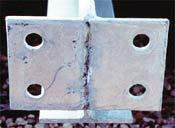Overlapped Surfaces
When designing articles to be galvanized after fabrication, it is best to avoid narrow gaps between plates, overlapping surfaces, back-to-back angles, and channels, whenever possible.

When overlapping of contacting surfaces cannot be avoided and the gap is 3/32-inch (2.5 mm) or less, all edges should be completely sealed by welding. The viscosity of the zinc keeps it from entering any space tighter than 3/32-inch (2.5 mm). If there is an opening, less viscous cleaning solutions will enter but zinc will not. Trapped solutions may cause iron oxide to weep out of the joint later on.
During the galvanizing process, steel is heated from ambient temperature to more than 800 F at a rapid pace. To prevent trapped moisture or gas from flashing to steam during this heating process, it is important to properly vent overlapping and contacting surface. Trapped moisture can result in minor concerns such as localized uncoated areas or more significant damage including rupturing the fabrication.
Consulting with your galvanizer before fabricating any overlapped piece is highly recommended as their experience can help you decide between a completely seal-welded joint and a skip-welded joint.
Consider the following challenges when galvanizing tightly overlapped surfaces :
- Cleaning solutions that may be trapped will flash to steam when the part is immersed in the galvanizing bath. This steam can wash the flux off of the part near the gap, causing bare areas adjacent to the lap joint.
- Cleaning solution salts can be retained in these tight areas due to the impossibility of adequate rinsing. The galvanized coating may be of good quality in the adjacent area, but humidity encountered weeks or even
months later may wet these salts. This will cause unsightly rust staining to seep out onto the galvanized coating. - Cleaning solutions will not effectively remove oils and greases trapped between surfaces in close contact. Any residual oil and grease will partially volatilize at the galvanizing temperature. This will result in an
unsatisfactory zinc coating in the immediate area of the lap joint.
For information on how to minimize issues, see the recommendations on Overlapped Surfaces in the Fabrication Considerations, including vent hole recommendations. Additional recommendations can be found in the specification ASTM A385.
